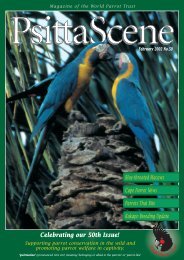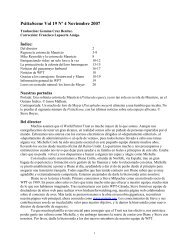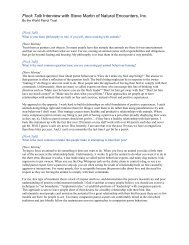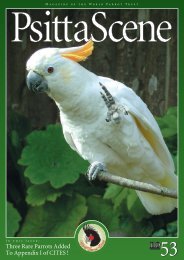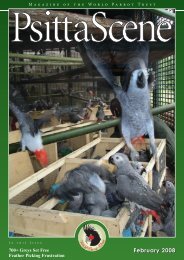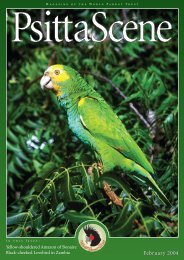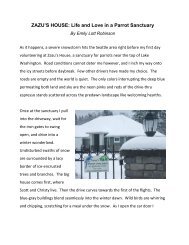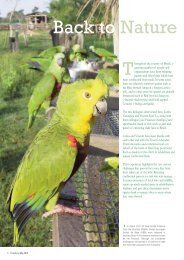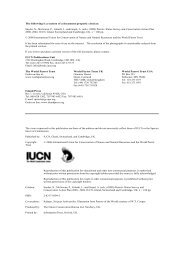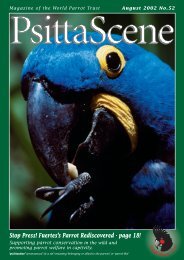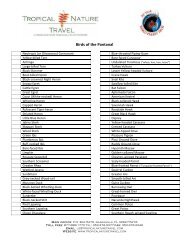Download - World Parrot Trust
Download - World Parrot Trust
Download - World Parrot Trust
Create successful ePaper yourself
Turn your PDF publications into a flip-book with our unique Google optimized e-Paper software.
Macaw wings on sale in the shop in Trinidad.<br />
Andrés is looking out for the<br />
red fronted macaw. It is the only<br />
macaw to live in this elevated<br />
and arid habitat. As far as I<br />
could discover the place to look<br />
is near Tambo, not shown on<br />
any map I could lay my hands<br />
on. We could discover no other<br />
details.<br />
The Red-fronted Macaw is<br />
known locally as the “Loro<br />
Burro” (Donkey <strong>Parrot</strong>) as it<br />
won’t speak. It lives in a very<br />
different habitat to the Bluethroated<br />
Macaw, living in the<br />
medium altitude semi-arid<br />
scrubland of the Eastern<br />
foothills of the Andes. Thorny<br />
bushes and trees along with<br />
giant cactus dominate the<br />
landscape. The temperature can<br />
range from sub-zero to 30°C.<br />
Rain usually arrives in the form<br />
of tropical storms.<br />
When we arrived in<br />
Pampagrande cold rain was<br />
falling with intermittent<br />
thunderstorms. Hermano Andrés<br />
runs a small bunk house with<br />
primitive facilities which was<br />
where we stayed. However it<br />
was a palace compared with how<br />
the local people live, in the most<br />
desperate of poverty and<br />
squalor. There is one small<br />
eating house which we used,<br />
also from time to time we dined<br />
with the good brother’s<br />
parishioners. The next morning<br />
it was still raining, the local<br />
river thundered by, heavy with<br />
silt and debris. Suddenly<br />
however over our heads flew a<br />
flock of Red-fronted Macaws, in<br />
the near freezing rain close to<br />
the cloud base. This is the only<br />
macaw I have seen that will fly<br />
in such conditions.<br />
The macaws migrate daily from<br />
their nesting and roosting places<br />
to their feeding places. Hermano<br />
Andrés has been keeping track<br />
of their numbers and<br />
movements for years, however<br />
is the first to admit to not<br />
having a complete picture by a<br />
long chalk. A much wider<br />
geographic study has been<br />
carried out by Robin Clark.<br />
So what did we<br />
find out about the<br />
Red Fronted<br />
Macaw?<br />
(a) This bird is also protected<br />
under CITES, but in the past<br />
has been heavily trapped.<br />
The method used was to<br />
spread nets over bait, when<br />
the birds landed their feet<br />
became entangled in the<br />
nets. Hermano Andrés has<br />
been actively promoting the<br />
conservation theme so<br />
hopefully in his area at least,<br />
this activity has been<br />
curtailed.<br />
(b) The Red-fronted Macaw nests<br />
in cliffs, but many of the<br />
nest sites used in the past<br />
More headdresses.<br />
are now abandoned.<br />
(c) The scrubby trees and cactus<br />
where this species feeds is<br />
being cleared and burned so<br />
reducing their habitat.<br />
Needless to say they are not<br />
welcome on the farmer’s<br />
maize crops that replaces it<br />
and have been shot in the<br />
past (and may still be).<br />
(d) A study was carried out some<br />
years ago by ornithologist<br />
Robin Clark. Virtually all of<br />
his recommendations were<br />
ignored, indeed the situation<br />
has worsened dramatically<br />
since that time.<br />
The Santa Cruz<br />
Zoo<br />
We also paid a visit to the Santa<br />
Cruz Zoo where we had heard<br />
that there are both Ara<br />
glaucogularis and Ara<br />
rubrogenys. This indeed proved<br />
to be the case, at the time there<br />
being eight of the former and<br />
between fifteen and twenty of<br />
the latter.<br />
At this zoo are kept, mostly in<br />
appalling conditions, nearly<br />
everything that walks and flies<br />
in South America. Here<br />
Photo: H. Armitage<br />
Photo: H. Armitage<br />
Macaw skulls.<br />
imprisoned in tiny cages are<br />
virtually every macaw you can<br />
think of, the giant Andean<br />
condor and the mighty harpy<br />
eagle. Urchins throw popcorn at<br />
the rare spectacled bears and<br />
jaguars. The maned wolf has<br />
died through neglect.<br />
This institution is, according to<br />
local conservationists, a clearing<br />
house for the rarest of<br />
collectable animals, which<br />
disappear and are replaced<br />
regularly.<br />
Birds and animals confiscated<br />
by customs and park officials<br />
are sent here, not one has ever<br />
been released into the wild.<br />
The Grisly Little<br />
Shop in Trinidad<br />
During our wanderings about<br />
Trinidad we stumbled across ‘La<br />
Ganaderia’, one of several craft<br />
shops to be found in Trinidad.<br />
It has a large stock of goods<br />
made from animal parts in<br />
which the macaw figures highly.<br />
Macaw wings and tails complete<br />
were for sale for about £2.00,<br />
Macaw skulls were for sale for<br />
about 50 pence. Also for sale<br />
were head-dresses (not Indian<br />
style made from the longer tail<br />
feathers but tourist style made<br />
from the wing feathers). Other<br />
items were made from ocelot<br />
and jaguar skins, anaconda and<br />
caiman.<br />
I am pleased to say that our<br />
webpage report has resulted in<br />
an absolute deluge of<br />
complaints. Several international<br />
organisations have taken up this<br />
case and I hope the pressure put<br />
on Bolivian authorities will<br />
cause them to act.<br />
Photo: H. Armitage<br />
PsittaScene Volume 11, No 4, November 1999 ■ 11




